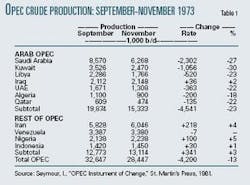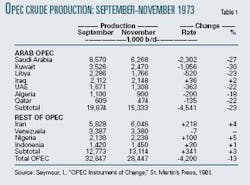The 1973 oil embargo: its history, motives, and consequences
The months preceding the 1973 embargo witnessed a marathon of negotiations over prices, taxes, and shares between governments of the oil-producing countries and the international oil companies (IOCs), which held long-term concessions. The pressure on oil prices started building up a few days before the embargo, when negotiations between the host countries and IOCs broke off. The Persian Gulf states, including Iran, reacted by unilaterally increasing the posted price by 70% on Oct. 16, 1973. The following day, members of the Organization of Arab Oil Exporting Countries (OAPEC), less Iraq, decided to use oil as a political weapon by cutting production without imposing any embargo. Some countries, such as Kuwait and the UAE, announced embargoes on oil exports to the US on Oct. 18. Saudi Arabia rejected calls to impose an embargo at first, but it imposed one on Oct. 19 after the Nixon administration of president Richard M. Nixon ignored warnings not to be biased toward Israel.
After the start of the October war, Kuwait called on OAPEC to meet in Kuwait City on Oct. 16 to discuss the use of oil to support the war efforts of Egypt and Syria. All countries except Iraq agreed to cut production by 5% from September levels. They would cut an additional 5% from the previous month�s production every month until Arab demands were met or until the economy of the individual country did not permit further cuts. They rejected calls for a complete halt in production and the imposition of embargoes on countries that supported Israel.
Iraq withdrew from the meeting. The Iraqi withdrawal created a problem for OAPEC. Consensus was required for an OAPEC resolution on production. The withdrawal of the Iraqis prevented OAPEC from issuing the resolution under the OAPEC umbrella. OAPEC ministers, less Iraq, circumvented this situation by convening under a different name: Conference of Arab Oil Ministers.
The Iraqis wanted OAPEC members to nationalize the assets of Western oil companies, impose a strict embargo on countries that supported Israel, break off diplomatic relations with these countries, and withdraw Arab funds deposited in these states. The Iraqis rejected the 5% cut on the ground that it punished friends and foes alike. The Persian Gulf countries viewed the Iraqi position as too extreme. Iraq took advantage of the situation and nationalized the assets of Dutch and US oil companies. Despite its radicalism, Iraq did not participate in the embargo and did not cut production. Instead, it announced its own embargo and at the same time increased production by 36,000 b/d (see table).
Cuts as pressure
OAPEC members, less Iraq, decided to use the production cut to pressure countries that supported Israel to change their policy toward the Middle East. On Oct. 17 these countries recommended that they "subject the United States to the most severe cut in proportion to the amounts of crude oil and products it imports from every exporting country."1 This nonbinding resolution was a mere "recommendation." Saudi Arabia played a significant role in issuing the above statement as a "recommendation" instead of as a "decision."2 By then it was clear that the Saudis supported production cuts but did not support an oil embargo.
Saudi Arabia used that recommendation to send a signal to Washington. It hoped Washington would heed Arab anger and reconsider its actions during the October war. The Nixon administration ignored the Saudi signals. It asked the US Congress on Oct. 19 to approve $2.2 billion for military aid to Israel. The Saudis were outraged and immediately imposed an embargo on all oil shipments to the US. Itayim provides several reasons for the Saudi action. In addition to King Faisal�s concerns regarding the US policy toward the Arab-Israeli conflict, he was frustrated when the US supplied Iran with its most sophisticated weaponry in an effort to replace the British presence in the Persian Gulf. The US had been withholding such types of sophisticated equipment from those Arab countries that needed and asked for them.2
Within a few days, Arab countries cut production between 5% and 10% and imposed a total embargo on oil shipments to the US. Saudi Arabia chose to cut production by 10% instead of the 5% that it agreed to a few days earlier. The Arab countries decided to impose another oil embargo on the Netherlands for allowing North Atlantic Treaty Organization bases within its territory to be used for the airlift of US military supplies to Israel. The embargo on the Netherlands lasted longer because it supplied Israel with oil during the war. Despite a decrease in the amount of oil shipped to the Netherlands, the available amount was almost double what the country needed for domestic consumption. Other oil embargoes were imposed on Portugal and South Africa.
Three groups
The Arab countries divided the world into three groups. Friendly nations would not experience any cut, neutral nations would experience 5% reduction in shipments, and hostile nations would be subject to the embargo. The embargo led to a 30% decrease in the production of oil in Saudi Arabia and Kuwait. Both countries treated their exports to the US and Holland as extra cuts above the original cuts. When OAPEC members, less Iraq, met again in November, they decided to increase the cut in production to 25%. Since the Saudi and Kuwaiti production cuts were set at 30%, the OAPEC revision upward to 25% brought about an increase in Saudi and Kuwaiti production. This increase compensated for the additional cuts by other countries.
When crude oil prices skyrocketed in early 1974, some OAPEC members felt that prices had become too high. The Saudis were concerned that high oil prices would destroy the economies of Western Europe; strengthen the Communist bloc; encourage the consuming countries to retaliate economically and militarily; stimulate alternative technology, which could make oil obsolete in the future; and break up the unity of OAPEC as countries started cheating to take advantage of high oil prices.3
The Saudis changed their behavior gradually. In October, Saudi Arabia demanded the full withdrawal of Israel from occupied territories according to UN Resolution 242. In December, they linked the removal of the oil embargo to a gradual Israeli withdrawal. In January 1974, oil ministers agreed to increase production by 10% instead of the planned cut of 5%. Weisberg argued that the embargo was a short-sighted reach for short-term gains.3 When the short-term gains were not achieved, Arab countries started to soften their demands. Once this process started, it killed the embargo. The embargo on the US officially ended on Mar. 18, 1974, and on the Netherlands on July 11, 1974.
References
1. Terzian, P., "OPEC: The Inside Story," Zed Books, 1985.
2. Itayim, F., "Arab Oil
3. Weisberg, R.C., "The Politics of Crude Oil Pricing in the Middle East, 1970-1975," Institute of International Studies, University of California, Berkeley, 1977.

